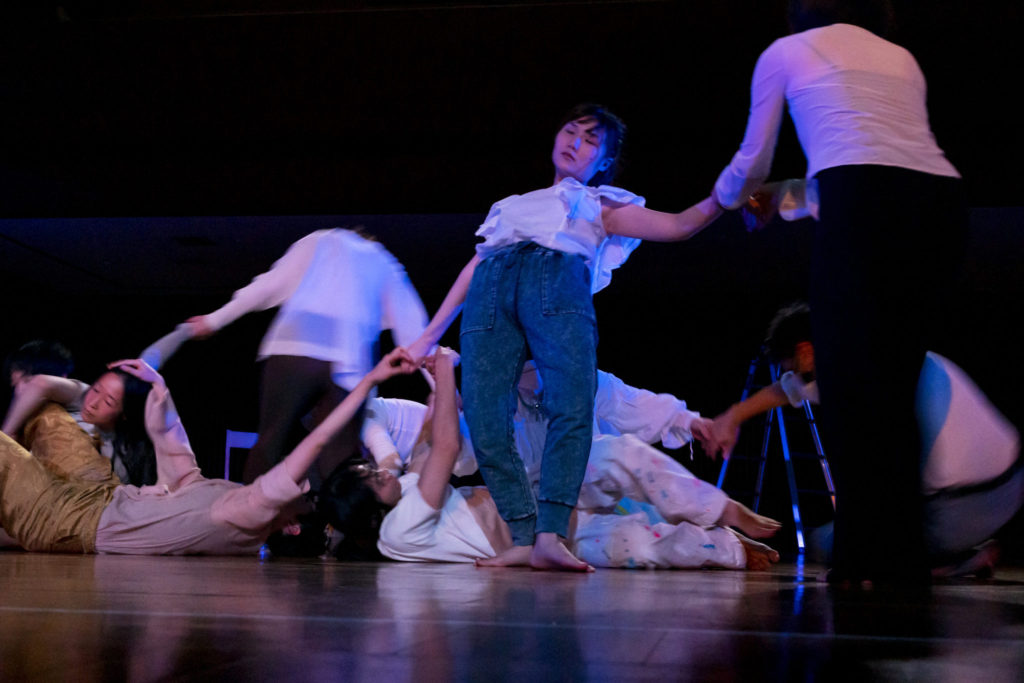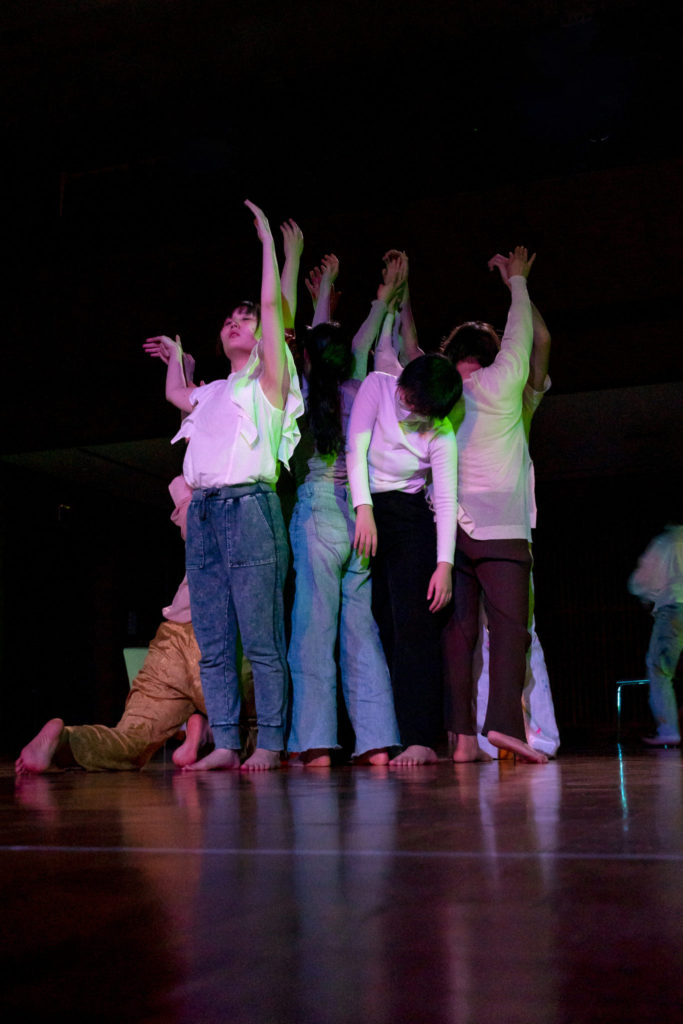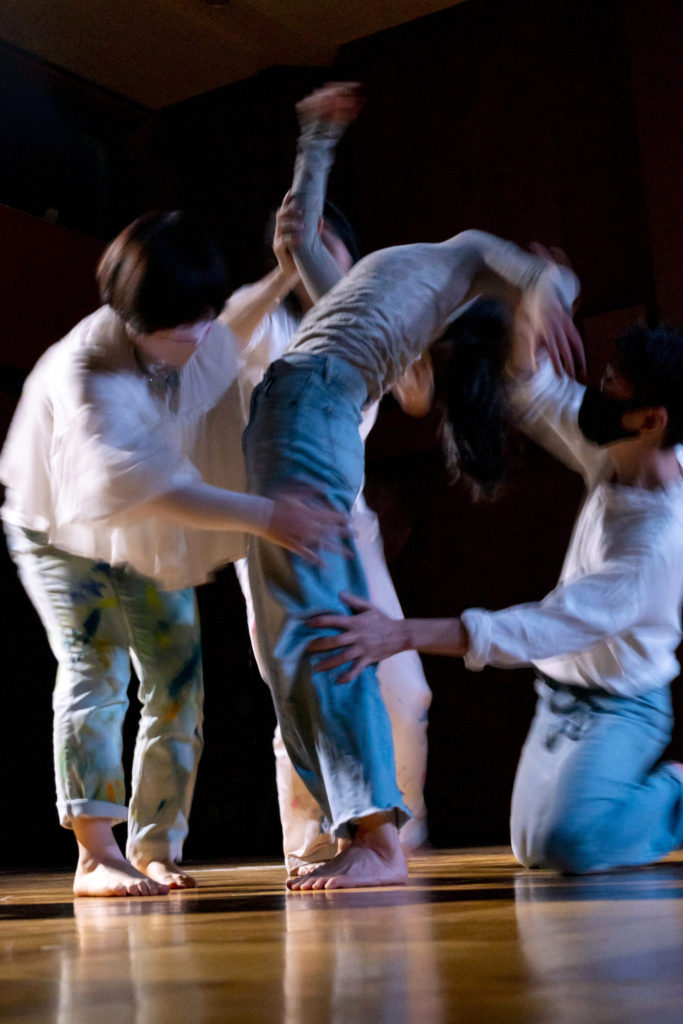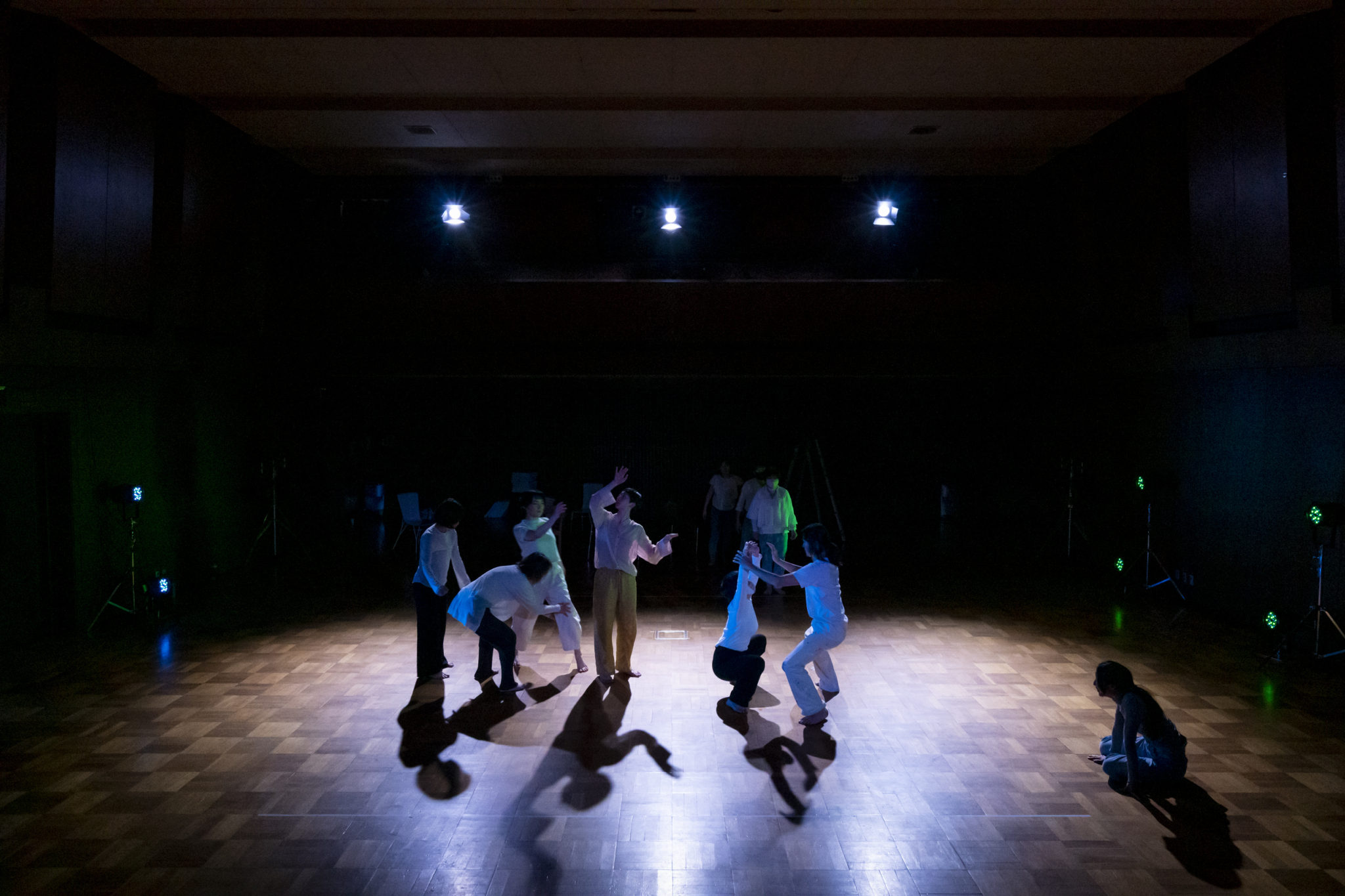Consultant and journalist Nobi Hayashi has been reporting on the latest in digital technology since 1990, covering the popularization of computers and the internet and how digitalization has altered the way we work and live. Having come to the realization that technology alone cannot bring about abundance, Hayashi’s reporting, writing, consulting, event planning, and business development work now crisscrosses disciplines including technology, design, art, fashion, and education, with a focus on the values that ought to be preserved into the 22nd century. He has written several books and is a visiting professor at the Kanazawa College of Art. Hayashi is an outside director at Revolver Inc and a member of the Good Design Award jury.
Photo: Tomoki Imai
A three-day event showcasing Ema Yuasa’s research process
The doors of the hall open, and as attendees look around for empty seats, 11 performers have already gathered for preparatory exercises. Soon the lights go down.
“Find a partner and scan each other’s bodies.”
From time to time, choreographer Ema Yuasa gives such directions for movement, speaking without a microphone. The performers reach out to each other and start scanning, their probing hands all but touching their counterpart’s body, as instructed by Yuasa. She looks out over the entire room, and at the right moment issues her next command. Background music plays at a low volume from the venue’s speakers. Occasionally, one hears fragments of recorded words over the sound, as if mumbled by the performers. “Situations you don’t understand are nice too…Hesitation is evident in their work, but a part of them really enjoys that hesitation.”
“I was clenching my teeth so hard that they started falling apart…”
Toward the end, the lights are lowered further and melancholy background music starts to play. The performers, scattered at first, split up: one of them rolls on the floor, while the others gather as if to express the anxiety in the lone performer’s heart. Then Yuasa intervenes, swinging violently between group and individual, as if in a struggle between body and soul, before coming to a sudden halt. A performer from the group steps up to Yuasa, who has collapsed from exhaustion, and gently wraps her arms around her as if to comfort her. This marks the sudden end of the showing, which is followed by a talk with Yuasa and some guests.

Photo: Tomoki Imai
Ema Yuasa’s “Unseen Gradation,” a public showing of her Xhiasma Research #002 project, was held over three days in mid-January. The above is a description of one version of the performance, which underwent significant changes over the course of the event.
Some may associate “Xhiasma” with the one-time performance of the same name by fashion designer Tamae Hirokawa, artist-scientist Akira Wakita, and dancer-choreographer Ema Yuasa, unveiled late at night at Tokyo Midtown in 2018. Xhiasma refers to chiasma, the X-shaped configuration at which chromosomes, including genes, cross each other. The project was named so in the hope that it would allow creatives from different genres to cross paths and create something new.
Yuasa recalls that collaborating with creatives from different fields on this project as well as on “enchaîne” (the second pre-performance of Dance New Air 2018), an earlier work that also included architect Tsuyoshi Tane, was a major turning point for her.
The experience inspired Yuasa to start Xhiasma Research on her own initiative. Rather than seeking to produce any performance works, this long-term research project focuses on the artistic process itself, and is an attempt to utilize the expertise and sensibilities of dancers in fields other than dance through workshops and dialogues.
A major inspiration for the first installment was an encounter with the visually impaired Mitsuko Takenouchi, who attended one of Yuasa’s research sessions in 2018, resulting in the development of light-induced movement. Held at the Kinosaki International Arts Center, it similarly included a workshop and talk.
For this second edition (2022), Yuasa’s main inspiration was “countertechnique,” which she says she came across during the Covid-19 pandemic.

Photo: Tomoki Imai
“Countertechnique” changes Yuasa’s outlook on dance
“Countertechnique” is the name of a technique for dancers, conceived by Anouk van Dijk of the Netherlands. Van Dijk started her own company in 1999 and has been involved in numerous stage productions as a dancer, choreographer, and artistic director, but her interest has gradually expanded to the methodology of dance itself.
Her discussions among friends and colleagues on issues such as how to dance more efficiently, how to open up to the audience with a calm mind during a performance, and how to take big risks without getting hurt, eventually came to fruition as Countertechnique. Van Dijk later summarized her discoveries, accumulated through these discussions, into six “toolboxes”: “Basic Principles,” “Perspective,” “ Energy,” “Space,” “Body,” and “Awareness.” The “basic principles” include elements such as encouraging the release of tension and letting body parts move about space, dynamically balancing the flow of the body, creating movement in the opposite direction to a certain movement as in an action-reaction relationship, and changing the distribution of one’s center of gravity. “Perspective” provides an assortment of specific tools to help determine which part of the body and which direction to emphasize when practicing the “Basic Principles.” The remaining four, divided into the categories of energy, space, bodily movement, and awareness, are tools that offer additional assistance while dancing. In Countertechnique, these six elements are mastered on an equal footing.
“Dance requires a lot of concentration and can be physically and mentally draining, but when a dancer has these toolboxes, he or she can put them to use when feeling lost,” van Dijk explains.
Yuasa says that she encountered this technique online during the pandemic and went on to acquire a teaching certificate in it. Immediately after the pandemic broke out, Yuasa was anxious because all of her scheduled performances were canceled, and she returned to her home in the Netherlands in a state of agitation, having lost the energy to dance. After that, she spent some time freeing herself from the behaviors she had disciplined herself for “as a dancer,” and was eventually able to start dancing again with the open mind of a child.
This wasn’t the first time Yuasa had been disappointed in dance. She recalls having a similar sense of frustration in 2015, before deciding to leave the world-renowned dance company Nederlands Dans Theater (NDT), which she had been part of for 11 years. In a talk with Anouk van Dijk at the end of 2022, Yuasa vented how she “could see what would happen to me if I stayed with the company. And beyond the future I envisioned, things started looking dull.”
“The dance world is hierarchical in the same way that many sports organizations are, and that includes the expectation that dancers will continue to follow certain teaching methods unquestioningly.” As a result, many dancers’ bodies suffer, and as they age, “they become physically immobile.”
In contrast, she was amazed to see that van Dijk, who teaches Countertechnique, was still able to move to the fullest among young dancers, even though she is a good deal older.
In response, van Dijk herself said that “Countertechnique allows dancers, who in the twenty-first century are required to perform a wide range of genres, to remain healthy both mentally and physically and to continue dancing without undue difficulty despite getting older. It is shaped by joint research involving many dancers, and is constantly being updated.”
Yuasa was fascinated by this aspect of Countertechnique.

Photo: Tomoki Imai
Gradations rather than classifications
Between September and December 2022, 24 workshops for dancers as well as the “Dance and Dialogue” workshop, which was open to non-dancers too, were held as part of Xhiasma Research #002 and included teaching in the elements of Countertechnique. The non-dancers invited to participate were mainly people who were experiencing difficulties in their daily lives and people with developmental disabilities, as per Yuasa’s belief that Countertechnique’s emphasis on liberating mind and body can “be extended to non-dancers” as well. Perhaps she was trying to find a way to make dance, to which she has devoted her life, useful to society more broadly, instead of only to a limited number of enthusiasts.
In what could be taken as a sign of this approach, two of the three talks featured as guests independent curator Akira Aoki and art director/graphic designer Takuma Hayashi (who designed the flyers for the project), neither of whom has any direct connection to dance. What Yuasa appears to be exploring is “dance” as a medium of communication for interacting with a wide variety of people.
In fact, she says that incorporating non-dancers had a positive effect on the dancers. In workshops with only dancers taking part, there’s a tendency to adopt a passive attitude to learning, with too much focus on mastering techniques, but by including non-dancers in the workshop, dialogue was created even while participants moved their bodies. Yuasa gained many insights through these dialogues, which were also featured in the showings. One of her observations is that although we are divided by aspects such as nationality, ethnicity, and line of work, and live in our separate silos, these differences are not always absolute distinctions, but rather more like gradations.
Those words also naturally tied dancers and non-dancers together. This was also what inspired Yuasa to name her research project “Unseen Gradation.”
The Covid-19 pandemic halted virtually all of humanity and brought about an opportunity to reflect on oneself once more. As the pandemic was finally coming to an end, Yuasa set out to summarize her past activities and took a step forward with the aim of connecting her work with the rest of society. As the world has entered an age of digitalization, where words tend to be exchanged only via the mind and the physical is often given short shrift, society has also become increasingly divided.
In contrast, Yuasa’s initiative is an ambitious attempt to transform such divisions into gradations through a focus on physical and mental health. Dance is often said to be a means of human communication that predates language, and this may be a step toward giving it such a social role once again. It’ll be interesting to see how Yuasa takes her experiment forward from here on.
Translated by Ilmari Saarinen
INFORMATION
Xhiasma Research #002 “Unseen Gradation” Public showings
Dates: January 13 - 15, 2023
Venue: Goethe-Institut Tokyo
Director: Ema Yuasa
Performers: Ema Yuasa, Miyu Motegi, Kazuki Ishiyama, Otoi, Rie Kato, Chikako Fujii, bundai, Kaho Nagata, Ayumi Han, Mameko, Mizuki Sumikawa
Organized by Xhiasma Executive Committee
Dance and Dialogue workshop: September–December 2022, Shibaura House









